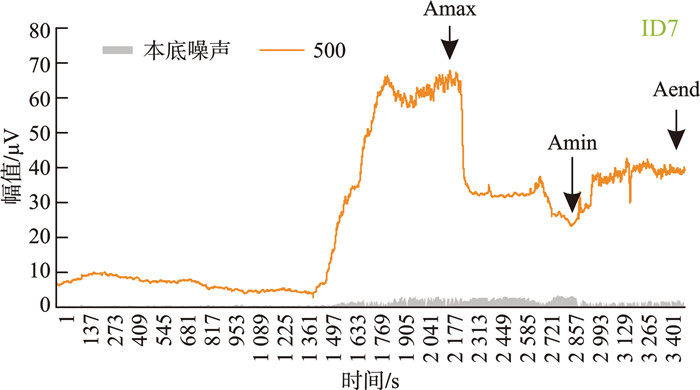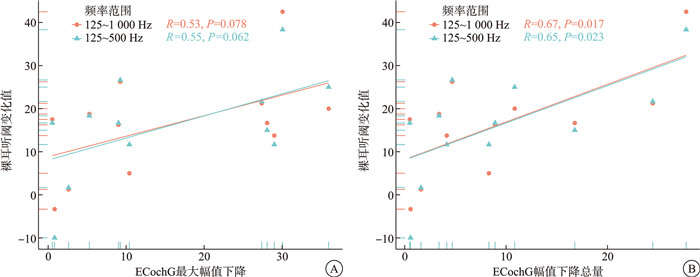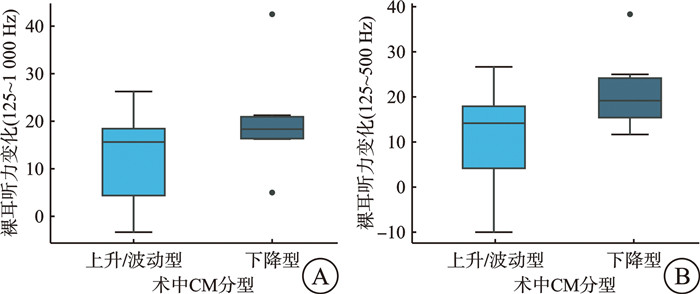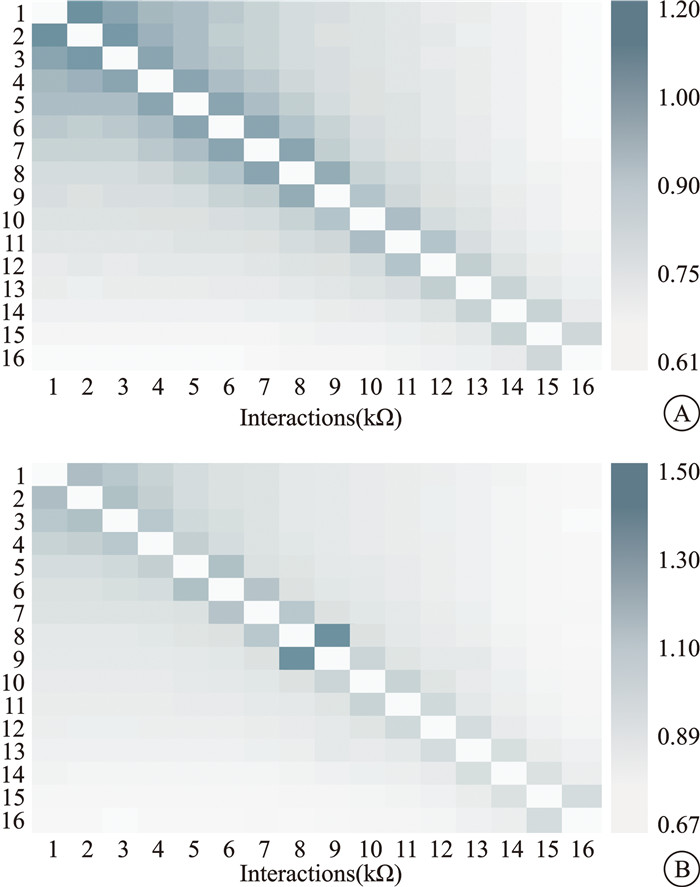A clinical study of electrocochleography monitoring for residual hearing retention during minimally invasive cochlear implant
-
摘要: 目的 探讨微创人工耳蜗植入(cochlear implant,CI)术中耳蜗电图(electrocochleography,ECochG)实时监测技术指导电极植入的应用价值,分析术中波形变化及植入方式与患者术后残余听力(residual hearing,RH)保留效果的相关性。方法 本研究纳入2022年6月至2024年7月进行CI手术的31例患者(共35耳)。术中均采用动态植入监测(active insertion monitoring,AIM)系统进行电极植入过程中的ECochG实时监测。记录术中耳蜗微音电位(cochlear microphonic,CM)波形变化,分析其与患者术后RH保留的相关性。结果 ① 所有35耳中成功记录到术中CM反应的有34耳(97.1%)。②根据Harris分型,A型(上升型)有7耳(20.6%)、C型(下降型)7耳(20.6%)、CC型(波动型)8耳(23.5%)、D型(无反应型)12耳(35.3%)。③CM幅值下降总量与术后低中频听力下降呈显著中度正相关(r=0.67,P=0.017)与术后低频听力下降呈显著中度正相关(r=0.65,P=0.023)。④平均幅值变化中,Amax为30.70 μV、Amin为8.64 μV、Aend为18.27 μV。⑤其中16耳进行了术后短期听力随访,低中频(125~1 000 Hz)听力损失为15.25 dB HL,RH保留率为87.5%。结论 微创CI植入术中ECochG实时监测技术可有效指导手术医生进行微创电极植入,术中CM波形变化可预估术后短期内的听力变化,ECochG术中监测有助于提高患者的RH保留效果。Abstract: Objective To investigate the application value of intraoperative electrocochleography(ECochG) monitoring technique and insertion techniques in cochlear implant(CI) and analyze its relationship with postoperative residual hearing(RH) preservation.Methods Thirty-one patients(35 ears) who received CI in our hospital from June 2022 to July 2024 were enrolled. The Advanced Bionics Active Insertion Monitoring(AIM) system was used for real-time ECochG monitoring during surgery. Intraoperative cochlear microphonics (CM) waveform changes were recorded and analyzed in relation to postoperative RH preservation.Results ① ECochG recordings were successfully obtained in 34 of 35 ears (97.1%). ②According to Harris classification, there were 7 ears(20.6%) of Type A(rising), 7 ears(20.6%) of Type C(declining), 8 ears(23.5%) of Type CC(fluctuating), and 12 ears(35.3%) of Type D(no response). ③The total CM amplitude decrease was significantly moderately correlated with postoperative low-mid frequency hearing loss(r=0.67, P=0.017). The total CM amplitude decrease was significantly moderately correlated with postoperative low frequency hearing loss(r=0.65, P=0.023). ④For the mean amplitude variation, the Amax was 30.70 μV, the Amin was 8.64 μV, and the Aend was 18.27 μV. ⑤Sixteen cases completed postoperative follow-up, with an average low-mid frequency(125-1 000 Hz) residual hearing loss of 15.25 dB HL and a RH preservation rate of 87.5%.Conclusion Intraoperative ECochG monitoring can effectively predict postoperative residual hearing changes, effectively guide surgical manipulation, and improve residual hearing preservation rate.
-
Key words:
- cochlear implantation /
- electrocochleography /
- residual hearing
-

-
表 1 31例(35耳)受试者基本信息
序号 性别 植入年龄/岁 病因 影像学 植入侧别 手术入路 植入电极 1 F 4 先天性 M,E L 圆窗 Advantage MS 2 F 4 先天性 M,E R 扩大圆窗 Advantage MS 3 M 42 不明原因 正常 L 圆窗 Advantage MS 4 F 50 不明原因 M,E R 圆窗 Ultra MS 5 F 15 不明原因 正常 L 圆窗 Ultra MS 6 F 31 先天性 M,E L 圆窗 Ultra SlimJ 7 F 23 先天性 M,E R 圆窗 Ultra SlimJ 8 F 43 突发性 正常 R 圆窗 Ultra MS 9 F 35 不明原因 正常 L 圆窗 Ultra MS 10 F 48 不明原因 正常 R 圆窗 Ultra MS 11 M 41 不明原因 正常 L 圆窗 Ultra SlimJ 12 M 64 外伤 正常 R 圆窗 Ultra SlimJ 13 M 36 先天性 正常 L 圆窗 Ultra MS 14 M 34 药物性 正常 L 圆窗 Ultra MS 15 M 7 先天性 M,E L 圆窗 Ultra SlimJ 16 F 23 不明原因 正常 R 圆窗 Ultra SlimJ 17 F 8 先天性 M,E L 圆窗 Ultra MS 18 M 23 先天性 正常 L 圆窗 Ultra SlimJ 19 M 23 先天性 正常 R 圆窗 Ultra SlimJ 20 M 60 不明原因 正常 R 圆窗 Ultra SlimJ 21 M 25 先天性 正常 L 圆窗 Ultra SlimJ 22 M 27 不明原因 正常 L 圆窗 Ultra SlimJ 23 F 45 药物性 正常 R 圆窗 Ultra MS 24 F 63 不明原因 正常 L 圆窗 Ultra MS 25 M 46 发热 正常 L 圆窗 Ultra MS 26 F 7 中耳炎 M,E L 圆窗 Ultra MS 27 F 30 不明原因 正常 L 扩大圆窗 Ultra MS 28 F 30 不明原因 正常 R 扩大圆窗 Ultra MS 29 M 7 先天性 M,E L 扩大圆窗 Ultra SlimJ 30 M 5 先天性 M,E R 扩大圆窗 Ultra MS 31 F 1 先天性 M,E L 扩大圆窗 Ultra MS 32 F 1 先天性 M,E R 扩大圆窗 Ultra MS 33 M 10 不明原因 正常 L 圆窗 Ultra MS 34 M 40 先天性 正常 R 扩大圆窗 Ultra MS 35 M 44 不明原因 正常 R 扩大圆窗 Ultra MS M:男,F:女;L:左侧,R:右侧;M:Mondini畸形,E:前庭导水管扩大。 -
[1] Gantz BJ, Hansen M, Dunn CC. Clinical perspective on hearing preservation in cochlear implantation, the University of Iowa experience[J]. Hear Res, 2022, 426: 108487. doi: 10.1016/j.heares.2022.108487
[2] 王睿婕, 罗建芬, 晁秀华, 等. 低频残余听力保留患者声电联合刺激短期效果观察[J]. 中华耳鼻咽喉头颈外科杂志, 2023, 58(12): 1173-1182.
[3] Tsukada K, Usami SI. Vestibular preservation after cochlear implantation using the round window approach[J]. Front Neurol, 2021, 12: 656592. doi: 10.3389/fneur.2021.656592
[4] Sosna-Duranowska M, Tacikowska G, Gos E, et al. Vestibular function after cochlear implantation in partial deafness treatment[J]. Front Neurol, 2021, 12: 667055. doi: 10.3389/fneur.2021.667055
[5] Wang RJ, Xu KF, Luo JF, et al. Vestibular function and hearing preservation in children following a minimally invasive cochlear implantation[J]. Eur Arch Otorhinolaryngol, 2024, 281(8): 4029-4038. doi: 10.1007/s00405-024-08504-4
[6] Ketterer MC, Shiraliyev K, Arndt S, et al. Implantation and reimplantation: epidemiology, etiology and pathogenesis over the last 30 years[J]. Eur Arch Otorhinolaryngol, 2024, 281(8): 4095-4102.
[7] 邹馨悦, 陈彪, 李永新. 双侧人工耳蜗植入现状及研究进展[J]. 临床耳鼻咽喉头颈外科杂志, 2024, 38(7): 666-670. doi: 10.13201/j.issn.2096-7993.2024.07.021
[8] 鲁兆毅, 潘滔, 王宇, 等. 32例儿童人工耳蜗再植入的术中问题及应对措施[J]. 临床耳鼻咽喉头颈外科杂志, 2023, 37(3): 218-221. doi: 10.13201/j.issn.2096-7993.2023.03.012
[9] Zhang L, Chen S, Sun Y. Mechanism and prevention of spiral ganglion neuron degeneration in the cochlea[J]. Front Cell Neurosci, 2021, 15: 814891.
[10] Xiang JL, Jin Y, Song NN, et al. Comprehensive genetic testing improves the clinical diagnosis and medical management of pediatric patients with isolated hearing loss[J]. BMC Med Genomics, 2022, 15(1): 142. doi: 10.1186/s12920-022-01293-x
[11] Bai X, Chen S, Xu K, et al. N-acetylcysteine combined with dexamethasone treatment improves sudden sensorineural hearing loss and attenuates hair cell death caused by ROS stress[J]. Front Cell Dev Biol, 2021, 9: 659486. doi: 10.3389/fcell.2021.659486
[12] Xu K, Chen S, Xie L, et al. The protective effects of systemic dexamethasone on sensory epithelial damage and hearing loss in targeted Cx26-null mice[J]. Cell Death Dis, 2022, 13(6): 545. doi: 10.1038/s41419-022-04987-3
[13] Bourn S, Goldstein MR, Jacob A. Hearing preservation in elderly cochlear implant recipients[J]. Otol Neurotol, 2020, 41(5): 618-624. doi: 10.1097/MAO.0000000000002596
[14] Schaefer S, Sahwan M, Metryka A, et al. The benefits of preserving residual hearing following cochlear implantation: a systematic review[J]. Int J Audiol, 2021, 60(8): 561-577. doi: 10.1080/14992027.2020.1863484
[15] Trecca EMC, Riggs WJ, Mattingly JK, et al. Electrocochleography and Cochlear Implantation: A Systematic Review[J]. Otol Neurotol, 2020, 41(7): 864-878. doi: 10.1097/MAO.0000000000002694
[16] Schuerch K, Wimmer W, Dalbert A, et al. Objectification of intracochlear electrocochleography using machine learning[J]. Front Neurol, 2022, 13: 943816. doi: 10.3389/fneur.2022.943816
[17] O'Leary S, Mylanus E, Venail F, et al. Monitoring cochlear health with intracochlear electrocochleography during cochlear implantation: findings from an international clinical investigation[J]. Ear Hear, 2023, 44(2): 358-370. doi: 10.1097/AUD.0000000000001288
[18] Lenarz T, Buechner A, Gantz B, et al. Relationship between intraoperative electrocochleography and hearing preservation[J]. Otol Neurotol, 2022, 43(1): e72-e78. doi: 10.1097/MAO.0000000000003403
[19] Harris MS, Koka K, Riggs WJ, et al. Can electrocochleography help preserve hearing after cochlear implantation with full electrode insertion?[J]. Otol Neurotol, 2022, 43(7): 789-796. doi: 10.1097/MAO.0000000000003588
[20] Valenzuela CV, Lichtenhan JT, Lefler SM, et al. Intracochlear electrocochleography and speech perception scores in cochlear implant recipients[J]. Laryngoscope, 2021, 131(10): E2681-E2688.
[21] Dietz A, Linder P, Iso-Mustajärvi M. A state-of-the-art method for preserving residual hearing during cochlear implant surgery[J]. J Vis Exp, 2023(195): e64021.
[22] Buechner A, Bardt M, Haumann S, et al. Clinical experiences with intraoperative electrocochleography in cochlear implant recipients and its potential to reduce insertion trauma and improve postoperative hearing preservation[J]. PLoS One, 2022, 17(4): e0266077. doi: 10.1371/journal.pone.0266077
[23] Skarzynski H, van de Heyning P, Agrawal S, et al. Towards a consensus on a hearing preservation classification system[J]. Acta Otolaryngol Suppl, 2013(564): 3-13.
[24] Harris MS, Koka K, Thompson-Harvey A, et al. Amplitude parameters are predictive of hearing preservation in a randomized controlled trial of intracochlear electrocochleography during cochlear implant surgery[J]. Otol Neurotol, 2024, 45(8): 887-894.
[25] Yin LX, Barnes JH, Saoji AA, et al. Clinical utility of intraoperative electrocochleography(ECochG)during cochlear implantation: a systematic review and quantitative analysis[J]. Otol Neurotol, 2021, 42(3): 363-371.
[26] Haumann S, Timm ME, Büchner A, et al. Intracochlear recording of electrocochleography during and after cochlear implant insertion dependent on the location in the cochlea[J]. Trends Hear, 2024, 28: 23312165241248973.
-

计量
- 文章访问数: 179
- 施引文献: 0



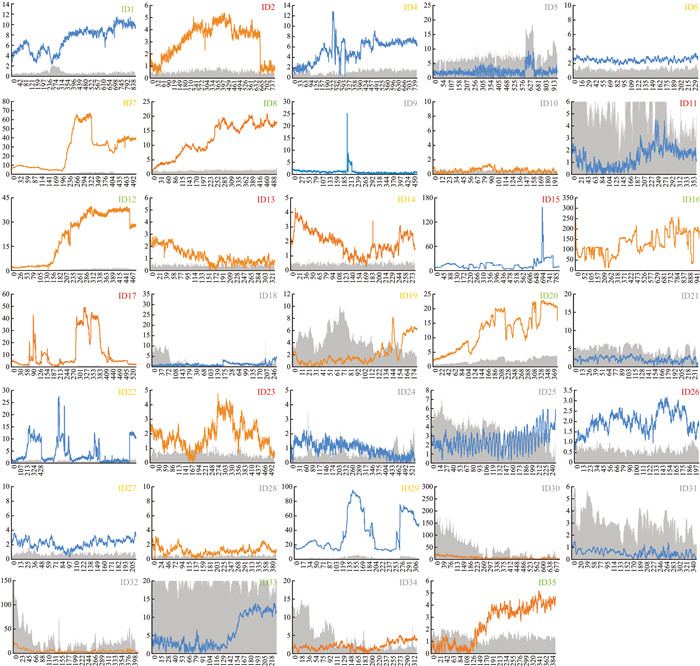
 下载:
下载:
